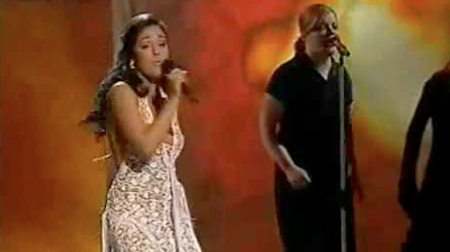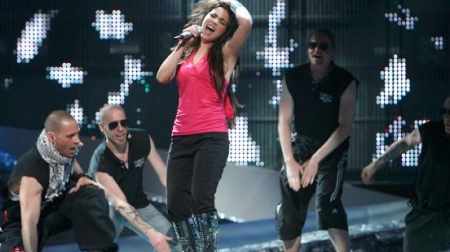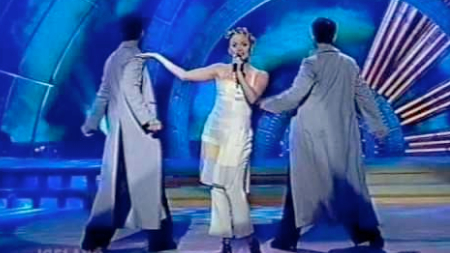John Egan is a New Zealand-based fan of the Contest, and something of a nerd. Oh, and a social scientist. After talking Ewan through some statistics on Eurovision points, he had some unfinished business with the running order and its effect on the result…
No matter the year, some questions are always the same. Did the draw impact the results? Was there a better song that got buried with an earlier draw? All Eurovision Song Contest fans seem to have opinions about this – many of us strong ones. But since I’ve been watching the Contest, there’s only been one year where I felt the winner was wholly undeserved. Even so, Latvia’s Marie N. won in 2002 by a comfortable twelve points over Malta. Which perhaps is down to the less than subtle way Ira Losco grabbed a fistful of glitter before the last key change. Just one man’s opinion.
In more general terms, I want to believe that a great entry – song, singer, performance and production – can win from anywhere in the draw. In fact, slot #2 to be more precise, the second song performed is the only draw left that’s never produced a winner. No one’s won from performing 26th either, but several songs have won performing last.

Ira Losco sings Lillie’s Blues
Let’s take a look at the result from the finals during the televoting era: 1997 through 2012. Since 1997 public voting has been a key element of how a winner was chosen, although we have used a mixed 50/50 televote and jury scoring method in the final since 2009 (it’s been used in the semi-finals as well since 2010). And let’s look not just as who wins, but who places well – in the top 3 in each contest: which countries’ entrants finish as win (1st), place (2nd) and show (3rd) as is used in horse racing. The bell rings… and we’re off!
It’s Just A Phase
A simple way to analyze the draw is to divide each final’s list of entries into 3 phases of roughly the same size. Most years have 24 entries, but we’ve had as few as 23 and as many as 26 any given year. That means each phase usually has 8 entries: in 1999 the middle (second) phase had only 7 entries, whilst in 2011 it had 9. In 2012, with 26 entries let’s say phase one and phase three each have 9 entries, and phase two has 8. All of this assumes, , that performing early or later is better than being stuck in the middle.
Applying this method, if we count the placements for the top 3 from these years we get:
Win: 11 from phase three, 3 from phase two, and 2 from phase one Place: 6 from phase three, 5 from phase two, and 5 from phase one Show: 6 from phase three, 6 from phase two, and 4 from phase one
In other words, almost half of the winners between 1997 and 2012 have performed in the last third of the show. If the distribution was balanced, it should have been around five from each phase: 16 divided by 3 is a bit more than 5. Instead we have 11, 3 and 2. At the same time, both place and show are relatively close to this balance (6, 5, and 5 versus 6, 6 and 4). That also means we’ve had 23 top 3 placements from phase three, 14 from phase two and 11 from phase one.
Which is interesting, in a nerdy sort of way, but doesn’t really help, for example, the Maltese delegation craft a winner.

Vodka can sometimes help you get through three minutes
Up until 2013 (when the producers will choose the draw for the final) the draw has been random, so there’s no way for a country to choose a specific place in the final. Historically, a late draw in the final has been equally good (20th draw, 2nd place in 2002 for Ira Losco’s ‘Seventh Wonder‘) and not so good (21st for both draw and placement in 2012 for Kurt Calleja’s ‘This is the Night‘) for the Maltese. Intriguingly, Chiara’s top placings in 1998 (3rd for ‘The One That I Love‘) and 2005 (2nd for ‘Angel‘) were both from phase one of the draw: when she sang a bit later in the draw in 2009 (14th) she finished in 22nd with ‘What if We‘. The entries that finished ahead of her were performed 8th (Israeli Dana International’s ‘Diva‘ before) and 16th (The UK’s ‘Where Are You?’ after) in 1998, and 19th (Greece’s Helena Paparizou’s “My Number One” after) in 2005.
Though most Chiara supporters would probably agree: her 2009 entry was her weakest.
Skew You
Another thing to bear in mind: only rarely in the televoting era have we had anything like a close contest in terms of the winner – even more rarely between all the top three entries. In 2003, the spread between win (Sertab Erener for Turkey with ‘Every Way That I Can’), place (Urban Trad for Belgium with ‘Sanomi‘) and show (the infamous t.A.t.U. for Russia with ‘Nje vjer, nje bojsa‘) was tiny: 3 points between all three placements. The next closest was 1998, where Israel beat the UK by 6 points, with Malta only 1 point farther back: a 7 point spread.
In all other years, the gaps widen – often dramatically.

Literally all out of luck
In 1999 Sweden’s Charlotte Nillson beat Iceland’s Selma by 17 points, with Germany’s Surpriz a further 6 points back: a 23 point spread. In 2004 Ukraine’s Ruslana beat Serbia and Montenegro’ Zeljko Joksomovic by 17 points, with Greece’s Sakis Rouvas a further 11 points back, for a 28 point spread. If one takes into account that 1999 had 23 voting countries and 2004 had about 1.5 times as many voting countries (36; it was the first time there was a fully contested semi-final), the differences are, in proportional terms, much smaller: 13 and 8 points approximately, for a spread of 21 points. 23 versus a 21 point spread between win and show is rather similar.
At the other end of the spectrum we’ve had two years that were total blow-out victories, with both the second and third place entries well back of the eventual winners. In 2009 Norway’s Alexandar Rybak scored a record 387 points winning with ‘Fairytale’, with second place Iceland’s Yohanna earning 218 points with ‘Is It True?‘: a spread of 169 points (Azerbaijan’s Aysel and Arash’s ‘Always’ was 11 points further back in third). In 2012 Loreen’s ‘Euphoria’ for Sweden romped to victory with 372 points , with Russia’s Buranovskiye Babubshki’s ‘Party for Everyone‘ on 259 points: a spread of 113 points (Serbia’s go-to guy Zeljko Joksomovic’s ‘Nije Ljubav Stvar‘ was another 45 points back in third). Both were performed in the third phase of the final: ‘Fairytale’ was performed 20th ‘Euphoria’ was performed 17th. Interestingly both songs had to qualify for the final and did so by winning its semi-final. Rybak performed 6th (phase one in an 19 entry semi-final) and won his semi-final. Loreen performed 11th (phase two in an 18 entry semi-final) and won hers as well
Since 2004 the margin of victory in most years has been somewhere between 32 and 44 points (mode), though the average (mean) margin of victory is 63 points.

Or you could ‘misplace’ the judge’s scoresheet
The Final Countdown
Out of 48 entries that have finished in the top 3 of Eurovision Song Contest finals in the 16 years of televoting, almost half – twenty three – have been performed in phase three. Out of 16 winners, 11 (69%) were performed in phase three. Our two massive winners were both performed in phase three. Our two winners with the narrowest wins, both performed in phase one.
Is there anything predictive here?
With different entries, different draws, different juries (somewhat) and different televoting audiences, each year is effectively a new Contest. But the representatives from each participating broadcasters know that the draw can make a difference between a good or very good placing – which for qualification out of the semi-final is particularly important. It’s not mere superstition that has led most countries with ‘wildcards’ for the semi-final draw allocation to pick one of the last three slots in their semi-final. Often to a good result.
The draw is significant, in other words. It’s not everything, but it has an impact.
The Name’s The Thing
But maybe we’re looking at too obvious an explanation for the outcome of these Contests. Making there’s some other mathematical principle in play that’s a better predictor. Here’s a list of the countries that have won the contest between 1997 to 2012:
- United Kingdom
- Israel
- Sweden
- Denmark
- Estonia
- Latvia
- Turkey
- Ukraine
- Greece
- Finland
- Serbia
- Russia
- Norway
- Germany
- Azerbaijan
- Sweden
Can you see any patterns? The winners in bold all have six letters in their English name; the winners in italics all have seven letters.
That’s right: eight winners with six letters and five winners with seven letters. Only the United Kingdom (13 letters, though United has six and Kingdom has seven) and Azerbaijan (ten letters) fall outside this pattern.
Perhaps Malta should add a letter to its name: Mallta or Maltta or Maltaa? Regardless, it doesn’t bode well for Bosnia & Hercegovina…
Images courtesy of Gabrel Lascu, Paolo Camera (Flickr CC), the EBU, and Eurovision.tv.









Funny, I was just scouring the web for any sign of a kiwi ESC community today. Let’s see who else this brings out of the woodwork.
Sorry, I don’t have anything useful to say about the article itself.
A great song can win from anywhere in the draw. A good song will struggle if drawn 1-11.
Technically, if you count Junior Eurovision, the second draw has produced a winner in one case- 2003.